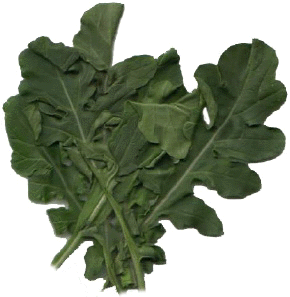...Best of Sicily presents... Best of Sicily Magazine. ... Dedicated to Sicilian art, culture, history, people, places and all things Sicilian. |
by Roberta Gangi | ||
Magazine Index Best of Sicily Arts & Culture Fashion Food & Wine History & Society About Us Travel Faqs Contact Map of Sicily |
When did arugula, a common complement to Italian salads, become a "snob" food? Eruca sativa (its scientific name), traditionally called rocket in England, is native to the entire Mediterranean. Strangely, the word "arugula" is not actually Spanish but rather an American-English word loosely based on the Italian and Spanish ones. It is an annual whose dark green leaves are edible. Arugula (rucola or rochetta to Italians) has a bitter and often sharp taste, especially if you break a bunch of leaves to release the scent of the plant's natural oils. Arugula is high in vitamin C and potassium, and grows best in somewhat dry soil. In Italian cuisine it appears in everything from pesto to pizza and even a liqueur, Rucolino --made on Ischia off the Neapolitan coast. The Romans knew of arugula and considered it an aphrodisiac, but until the twentieth century it was rarely cultivated anywhere. Arugula was something wild that people simply picked in the country, kind of a weed. In other words, it was virtually ignored by most people. Here in Italy arugula is priced comparably to fresh basil, mint and other herbs. In the 1980s it was widely introduced in the UK, US and other markets where it had previously been an esoteric niche food, usually sold at an overzealously inflated retail price as a "gourmet" item. Thus began the sad tale of the plant's elitist image. It was one of those unfortunate cases of a handful of people using knowledge or possession of a certain thing as a pretext for deriding the lack of "sophistication" of those unfamiliar with it. On the plus side, however, a best-selling book, The United States of Arugula, heralded changing (and increasingly nutritious) tastes among at least some Americans. In 2008, when US presidential candidate Barack Obama mentioned arugula during a speech to some Iowa farmers, he was criticised by the press as a "cultural elitist," though in truth the debate prompted the press to say that all the candidates were "elitist" in this respect. The Economist went so far as to brand Obama's Democratic supporters as "wine drinkers" and Hillary Clinton's as "beer drinkers," while emphasising that the lifestyle of the latter bore little resemblance to those of her supposed constituency. Arugula isn't the first innocent vegetable to suffer this fate. Radicchio, a distant cousin of common lettuce also used in Mediterranean cookery, was for some years the object of social critics' disdain. A number of Italian foods have suffered the same social fate. What's important is that arugula survives and makes its way into your plate. About the Author: Roberta Gangi has written numerous articles and one book dealing with Italian cultural and culinary history, and a number of food and wine articles for Best of Sicily Magazine. | |
Top of Page |
 It's interesting
how certain plants come to represent characteristics
far beyond what Nature probably intended. Laurel and oak leaves are symbolic
of honour, victory and achievement. Palm branches represent peace. Holly
and fir are associated with Christmas. And so forth. Matters get trickier
with things we eat, especially when those foods perfectly commonplace --perhaps
even mundane-- in one region are ascribed a completely different importance
in another. So rice is more revered by Japanese than Canadians, while most
Christians eat pork (shunned at many Muslim and Jewish tables) but wouldn't
eat dog (a popular dish in Korea).
It's interesting
how certain plants come to represent characteristics
far beyond what Nature probably intended. Laurel and oak leaves are symbolic
of honour, victory and achievement. Palm branches represent peace. Holly
and fir are associated with Christmas. And so forth. Matters get trickier
with things we eat, especially when those foods perfectly commonplace --perhaps
even mundane-- in one region are ascribed a completely different importance
in another. So rice is more revered by Japanese than Canadians, while most
Christians eat pork (shunned at many Muslim and Jewish tables) but wouldn't
eat dog (a popular dish in Korea).